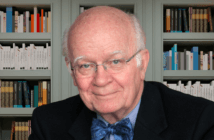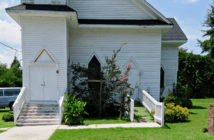In 2014, Amy Butler stepped into the pulpit of The Riverside Church in Manhattan, a church well known for its public witness and prominent pastoral leaders. She shares advice on taking the helm of a well-established congregation and leading change within a historic institution.
Those of us called to lead institutions with long and prominent histories have a big task on our hands. It can be excruciatingly difficult to move a “stuck” institution. It requires sophisticated leadership — leadership that involves politics, management, and other professional skills not generally taught in seminary. And the challenge is greater today than it was in the 1950s, because it’s harder to get people in the doors of the church. Fear and a sense of scarcity come more readily to the surface in this era of institutional decline. It can be harder to live into the risky discipleship God requires of us.
Theology
Leaders in well-established institutional settings know all too well the challenge of hearing, day in and day out, “But we’ve always done it that way,” or being followed around by people carrying highlighted, dog-eared copies of the bylaws. It takes a strong leader with a very clear theological framework who is willing to experience and live through this challenge in order to teach a theological framework and to create a community that will allow the discomforting winds of God’s Spirit. Institutional change requires an ability to pivot with the winds of God’s Spirit.
Relationships
I have learned that the only way things change is through relationship. I spent a large part of my first three years at Riverside building relationships with the congregation. I did that by being in the pulpit as much as I could, by standing at the door in the back as people left worship, by keeping four appointments a week on my schedule for any member of the congregation who wanted to come and talk. I started The Pastor’s Table, breakfast meetings twice a month at my home with diverse groups of ten members of the congregation. This type of intentional relationship building formed a level of trust that allowed us to hold one another’s hands through some of the tough transitions.
Fresh perceptions
One of the challenges of leading a well-established church is that many people have already formed a perception of the church that can be hard to shake. An important part of transformational leadership is creating a new vision of who you want to be — not something that is inauthentic or untrue, but something you can live into. When I came to The Riverside Church, its reputation was holding fairly strong, but it was a bit dusty. My job was to brush it off, shine it up, and project to the world who we are growing to be. Social media has been a powerful tool for us to project who we are and who we hope to become.
We also started changing the way things looked around the building. Riverside is a big stone cathedral that can make some feel as if they are walking into a torture chamber. We wanted to project a more positive, welcoming image to the many people who stream through our building each day, going to the nursery school, classes, or various events. We changed the light bulbs to make spaces brighter and more welcoming. We put up pictures around the building that reflect the life of our community and an image of who we want to be together. These may seem like minor things, but their impact can’t be discounted.
Changing times, changing measures of success
We are at a very interesting moment in the history of the church that requires experimentation — thinking about how we evangelize through social media and how we build community in a virtual space. If we try to measure our success by traditional metrics, we will fail because the church is no longer a popular social institution. It’s no longer just a matter of what people give or how many come to worship, but how many times we touch another person’s life either virtually or in person. We must ask ourselves how many lives are changed through community programming and online engagement, whether there is a spirit of love and kindness in this place, and if we treat one another with respect.
I’ve made a lot of mistakes. But learning by trial and error is part of the process. The exciting thing is discovering the tremendous potential of reaching people through livestream, social media, and other means we wouldn’t have even thought of a few years ago.
Related Resources
- “Leading a Historic Congregation,” a Leading Ideas Talks podcast episode featuring Amy Butler
- Begin with Where by Rev. William H. Lamar
- The Right Start: Beginning Ministry in a New Setting Video Tool Kit
- Take the Next Step: Leading Lasting Change in the Church (Abingdon Press, 2003) by Lovett H. Weems, Jr.







